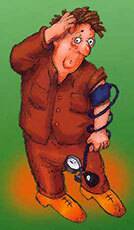If the concept of "hypertension", many people have encountered, that is - a portal, the majority unknown. Portal hypertension - a syndrome characterized by constantly elevated blood pressure due to impaired circulation process in the portal vein. Accompanied by the development of the syndrome of diseases of the gastrointestinal tract.

Causes of
Hypertension gantry - a pathological process in which blood vessel wall weakened in which increases the volume of blood as a result - there is an increase in pressure that are sustainable, permanent character.
There is a kind of portal hypertension, liver cirrhosis advantageously when soft tissue scarring formed impeding the full blood flow. Gate Vienna - a major blood vessel through which blood goes from the stomach, spleen, esophagus, bowel (excluding the rectum) to the liver.
The causes of portal hypertension may be as follows:
- varicose veins in the esophagus;
- overlap vein supplying spleen, thrombus;
- atresia (partial or complete absence) or stenosis (narrowing) of the walls of the portal vein, bearing innate;
- schistosomiasis - infestation of the body;
- biliary cirrhosis type in the initial stage of development;
- polycystic;
- the presence of cancer metastasis, affecting the liver or spleen;
- cirrhosis;
- alcoholic hepatitis type acute course;
- hepatic vein thrombosis;
- the development of cardiac insufficiency of the right ventricle;
- in chronic hepatitis;
- increasing the volume of blood in the spleen.

All these factors lead to the fact that the process of blood circulation in the liver is broken.
Classification
The disease is divided into several types. Classification of portal hypertension is based on the etiology of the disease:
- Predpechenochnaya - impaired blood flow in the vein until it flows into the liver.
- Intrahepatic - poor circulation occurs in the portion of the vein, which is inside the body.
Intrahepatic hypertension is divided into subspecies:
- presinusoidalnaya;
- sine;
- postsinusoidalnaya.
Other types of the disease:
- postpechenochnaya - disturbed circulation in the veins, which carry blood from the inferior vena cava;
- Mixed - this kind of disease combines several separate types of hypertension.

The classification of the disease as it develops:
- Preclinical, initial.
- Compensated with moderately symptomatic picture.
- Decompensated, with severe symptoms.
- Complications leading to the development of many complications.
Each of the stages has a symptomatic picture of the extent and risk of complications, apply to the digestive system.
Symptoms and signs
Portal hypertension syndrome has the following symptomatic picture in step 1:
- a feeling of heaviness in his right side;
- flatulence;
- deterioration of general condition.

Signs of portal hypertension by 2 stages:
- increase in the intensity of pain in the right side;
- bloating;
- signs of the process of digestion;
- epigastric pain;
- feeling of eating after consuming small amount of food;
- frequent signs of nausea.
Symptoms of portal hypertension by 3 step accompanied by the development of ascites - pathology at which accumulates in the peritoneal cavity fluid, but without bleeding.
Manifestations of the disease in 4 stages:
- complicated ascites, which can not be cured with medication;
- bleeding of internal organs;
- signs of varicose veins in the digestive system.

Patients with this syndrome may develop in parallel other diseases, including cardiovascular diseases, which lead to a sustainable increase in blood pressure and the development of hypertension.
Diagnostics
For an accurate diagnosis is required to conduct a comprehensive examination of the patient, including laboratory and instrumental methods:
- A psychological evaluation of the patient, analysis of the major complaints and compiling medical history to determine the causes of the disease.
- Conducting blood count. The main indicator - the level of platelets, which are responsible for the process of blood clotting.
- Coagulation - This analysis allows to track slow the formation of blood clots in the vessels by reducing the quantitative content of hepatic enzymes.
- Biochemical blood analysis - allows to identify the disease, the root cause of the occurrence of hypertension.
- Investigation of liver enzymes - is carried out to analyze the status and functioning of the organ.
- General examination of urine - evaluates the condition and function of the urinary system.
- US - evaluates the dimensions and the diameter of the spleen and liver. Examination shows the presence of fluid in the gastrointestinal tract organs, to determine the patency of vein diameter and feeding organs.
- CT - computed tomography spiral type - instrumental examination, during which the doctor is the most accurate images of internal organs, allowing them to consider the presence of pathological processes.
- MRI - technique to study the internal organs with the highest resolution images of internal organs.
- Roentgen circulatory system using a contrast agent - defines venous constriction hindering normal blood circulation, and are the cause of high blood pressure.

If all of the above laboratory and instrumental methods of examination do not give a complete picture of the state of the liver and circulatory organ system, it is necessary to resort to laparoscopy - technique inspection intraperitoneal space with an optical instrument.
Treatment
When portal hypertension treatment is carried out in a hospital inpatient and includes a set of measures. In the early stages of the disease applied medical therapy. If the disease has been launched, the only method of treatment - surgery.
conservative therapy
Treatment of portal hypertension is held the following medications:
- Hormonal substances produced by the pituitary gland - helps lower blood pressure and reduce the burden imposed on the liver and spleen. Their operating principle is to narrow the lumen of the small blood vessels of the circulatory system.
- Nitrates - drugs, the main active substance which acts as a nitric acid salt. Drugs have on the blood vessels to expand action.
- Somatostatin synthetically derived, - hormonal substances that are produced by the brain. Their activity spectrum is to suppress the generation process of other hormones. The funds help to reduce the intensity of symptomatic picture of hypertension.

Treat syndrome pathological need diuretics, drugs based on lactulose and antibiotics if the disease is associated with the development of infectious diseases of the digestive organs system.
Surgical intervention
By the operation is necessary to resort to if drug therapy over an extended period does not give a positive result. Applied methods:
- Shunting - forming additional blood stream bypassing the damaged vessels.
- Devascularization - ligation of damaged arteries and veins in order to reduce the pressure in the digestive organs.
- Transplantation - carried out when other methods of surgery can not provide a positive therapeutic outcome. The transplantation of liver cells is performed in most cases of blood relative.
After the surgery goes a long rehabilitation period in compliance with the dietary Supply and reception of drugs that promote the regeneration and restoration of liver function and spleen.
prevention
Measures to prevent the occurrence of hypertension, portal type and its recurrence after surgical or medical treatments primarily include maintaining proper lifestyle. To avoid problems with the blood vessels of the liver, proper nutrition must be observed, give up all bad habits, time to treat infectious and other digestive diseases system.

People after therapy should be 1 per year undergo preventive medical examinations.
Consequences and outlook
With timely treatment of the disease in the early stages of a favorable prognosis. If the syndrome has been started, the following complications may develop anemia, internal bleeding, hepatic encephalopathy, anastomoses.
With the development of complications of portal hypertension in the background kind of less favorable prognosis in most cases require surgery with a long rehabilitation period and high risk relapse.
Launched hypertension at the last stage without maintenance therapy can lead to a total disturbance of the functioning of the liver and spleen, which pulls the entire digestive dysfunction system. Not ruled out death.



